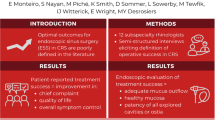Abstract
Postoperative pain after functional endoscopic sinus surgery (FESS) and its optimal management has not been described in detail. The objective was to evaluate pain, its influencing factors and its management on the first postoperative day following FESS. In a prospective case study, 101 FESS patients were examined after removal of the nasal packing within the Quality Improvement in Postoperative Pain Management (QUIPS) project allowing a standardized assessment of patients’ characteristics, pain parameters, outcome and process parameters. The influence of these parameters on the patients’ postoperative pain was estimated by univariate and multivariate statistic analysis. Pain during the first postoperative day after FESS was moderate. Younger patients reported significantly more pain than did older patients. Specific counseling about the possibilities of postoperative pain management reduced pain intensity highly significantly in univariate and multivariate analysis. Patients demanding for pain relief in the recovery room and on the ward predominantly received acetaminophen as non-opioid and piritramide as opioid. This pain management was obviously insufficient as these patients still reported significantly more from pain on the first postoperative day than patients not demanding for pain relief. We conclude that QUIPS could help to optimize the quality of postoperative pain management following FESS.
Similar content being viewed by others
References
Savoia G, Alampi D, Amantea B, Ambrosio F, Arcioni R, Berti M, Bettelli G, Bertini L, Bosco M, Casati A, Castelletti I, Carassiti M, Coluzzi F, Costantini A, Danelli G, Evangelista M, Finco G, Gatti A, Gravino E, Launo C, Loreto M, Mediati R, Mokini Z, Mondello E, Palermo S, Paoletti F, Paolicchi A, Petrini F, Piacevoli Q, Rizza A, Sabato AF, Santangelo E, Troglio E, Mattia C (2002) Postoperative pain treatment SIAARTI Recommendations 2010. Short version. Min Anestesiol 76:657–667
Neugebauer E, Sauerland S, Keck V, Simanski C, Witte J (2003) Surgical pain management. A Germany-wide survey including the effect of clinical guidelines. Chirurg 74:235–238
Rathmell JP, Wu CL, Sinatra RS, Ballantyne JC, Ginsberg B, Gordon DB, Liu SS, Perkins FM, Reuben SS, Rosenquist RW, Viscusi ER (2006) Acute post-surgical pain management: a critical appraisal of current practice, December 2–4, 2005. Reg Anesth Pain Med 31:1–42
Gordon DB, Dahl JL, Miaskowski C, McCarberg B, Todd KH, Paice JA, Lipman AG, Bookbinder M, Sanders SH, Turk DC, Carr DB (2005) American pain society recommendations for improving the quality of acute and cancer pain management: American Pain Society Quality of Care Task Force. Arch Int Med 165:1574–1580
Kehlet H, Wilkinson RC, Fischer HB, Camu F (2007) Prospect: evidence-based, procedure-specific postoperative pain management. Best Pract Res Clin Anaesthesiol 21:149–159
Kemppainen TP, Tuomilehto H, Kokki H, Seppa J, Nuutinen J (2007) Pain treatment and recovery after endoscopic sinus surgery. Laryngoscope 117:1434–1438
Rosenquist RW, Rosenberg J (2003) Postoperative pain guidelines. Reg Anesth Pain Med 28:279–288
Meissner W, Ullrich K, Zwacka S (2006) Benchmarking as a tool of continuous quality improvement in postoperative pain management. Eur J Anaesthesiol 23:142–148
Meissner W, Mescha S, Rothaug J, Zwacka S, Goettermann A, Ulrich K, Schleppers A (2008) Quality improvement in postoperative pain management: results from the QUIPS project. Dt. Arztebl Int 105:865–870
D’Hoore W, Sicotte C, Tilquin C (1993) Risk adjustment in outcome assessment: the Charlson comorbidity index. Meth Inform Med 32:382–387
Eliashar R, Gross M, Wohlgelernter J, Sichel JY (2006) Packing in endoscopic sinus surgery: is it really required? Otolaryngol Head Neck Surg 134:276–279
Arya AK, Butt O, Nigam A (2003) Double-blind randomised controlled trial comparing Merocel with rapid rhino nasal packs after routine nasal surgery. Rhinology 41:241–243
Buchanan MA, Dunn GR, Macdougall GM (2005) A prospective double-blind randomized controlled trial of the effect of topical bupivacaine on post-operative pain in bilateral nasal surgery with bilateral nasal packs inserted. J Laryngol Otol 119:284–288
Leunig A, Betz CS, Siedek V, Kastl KG (2009) CMC packing in functional endoscopic sinus surgery: does it affect patient comfort? Rhinology 47:36–40
Chester AC, Sindwani R, Smith TL, Bhattacharyya N (2008) Systematic review of change in bodily pain after sinus surgery. Otolaryngol Head Neck Surg 139:759–765
Wise SK, Wise JC, DelGaudio JM (2005) Evaluation of postoperative pain after sinonasal surgery. Am J Rhinol 19:471–477
Baker AR, Baker AB (2010) Anaesthesia for endoscopic sinus surgery. Acta Anaesthesiol Scand 54:795–803
Gehling M, Arndt C, Eberhart LH, Koch T, Kruger T, Wulf H (2010) Postoperative analgesia with parecoxib, acetaminophen, and the combination of both: a randomized, double-blind, placebo-controlled trial in patients undergoing thyroid surgery. Br J Anaesth 104:761–767
Karaaslan K, Yilmaz F, Gulcu N, Yigit B, Kocoglu H (2007) The effect of prilocaine and prilocaine plus meperidine infiltration on the pain during nasal packing removal. Rhinology 45:321–324
Poller K, Volk GF, Wittekindt C, Meissner W, Guntinas-Lichius O (2011) Estimation of postoperative pain after tonsillectomy in adults using QUIPS: an instrument to improve postoperative pain management. Laryngol Rhinol Otol 90:82–89
Melotti RM, Samolsky DBG, Carosi F, Ricchi E, Chiari P, D’Andrea R, Di Nino G (2009) Categories of congruence between inpatient self-reported pain and nurses evaluation. Eur J Pain 13:992–1000
Gordon DB, Rees SM, McCausland MR, Pellino TA, Sanford-Ring S, Smith-Helmenstine J, Danis DM (2008) Improving reassessment and documentation of pain management. Joint Commission Res 34:509–517
Conflict of interest
The authors declare no financial relationship or competing interests.
Author information
Authors and Affiliations
Corresponding author
Appendices
Appendix 1: Part one of QUIPS: the questionnaire for the patient. Original questionnaire is in German. Translation by the authors

Appendix 2: Part two of QUIPS: collection of pain-related parameters. Original form is in German. Translation by the authors

Rights and permissions
About this article
Cite this article
Finkensieper, M., Poller, K., Wittekindt, C. et al. Postoperative pain assessment after functional endoscopic sinus surgery (FESS) for chronic pansinusitis. Eur Arch Otorhinolaryngol 270, 157–166 (2013). https://doi.org/10.1007/s00405-012-2015-6
Received:
Accepted:
Published:
Issue Date:
DOI: https://doi.org/10.1007/s00405-012-2015-6




